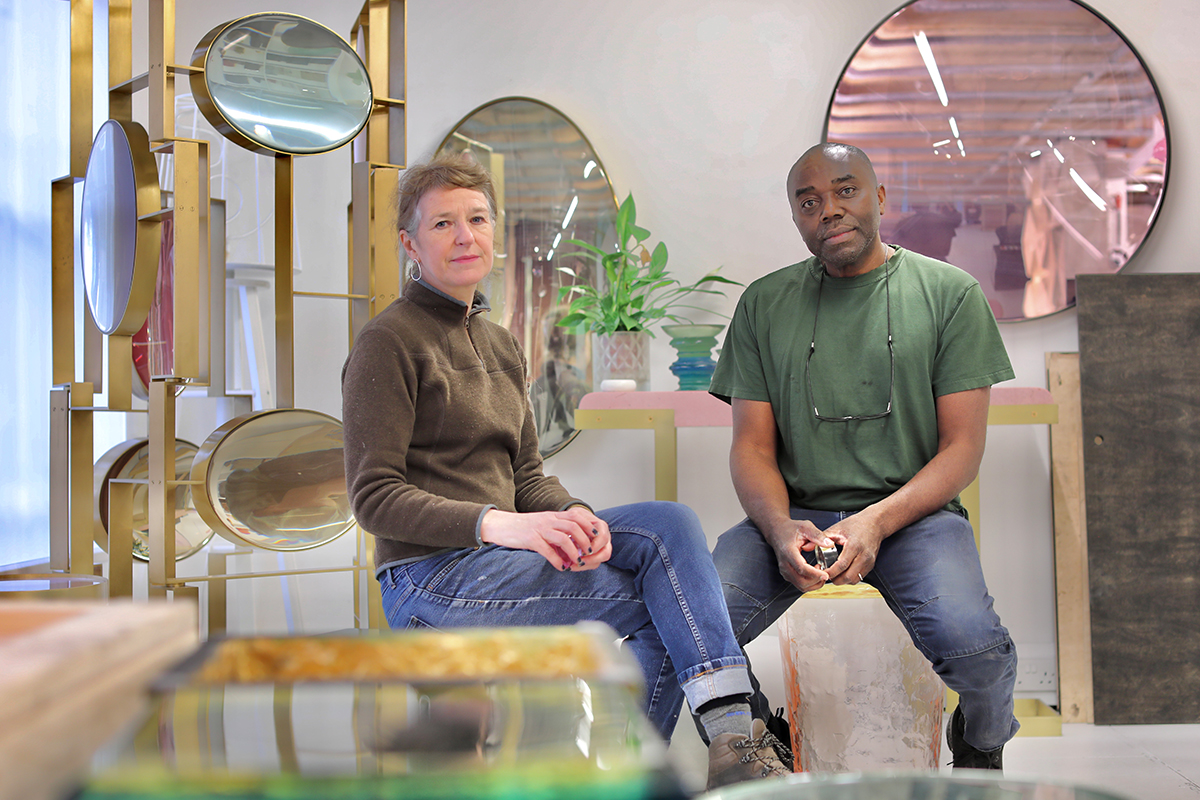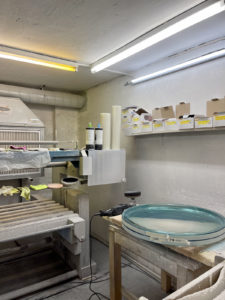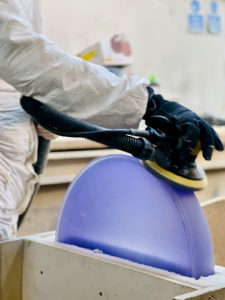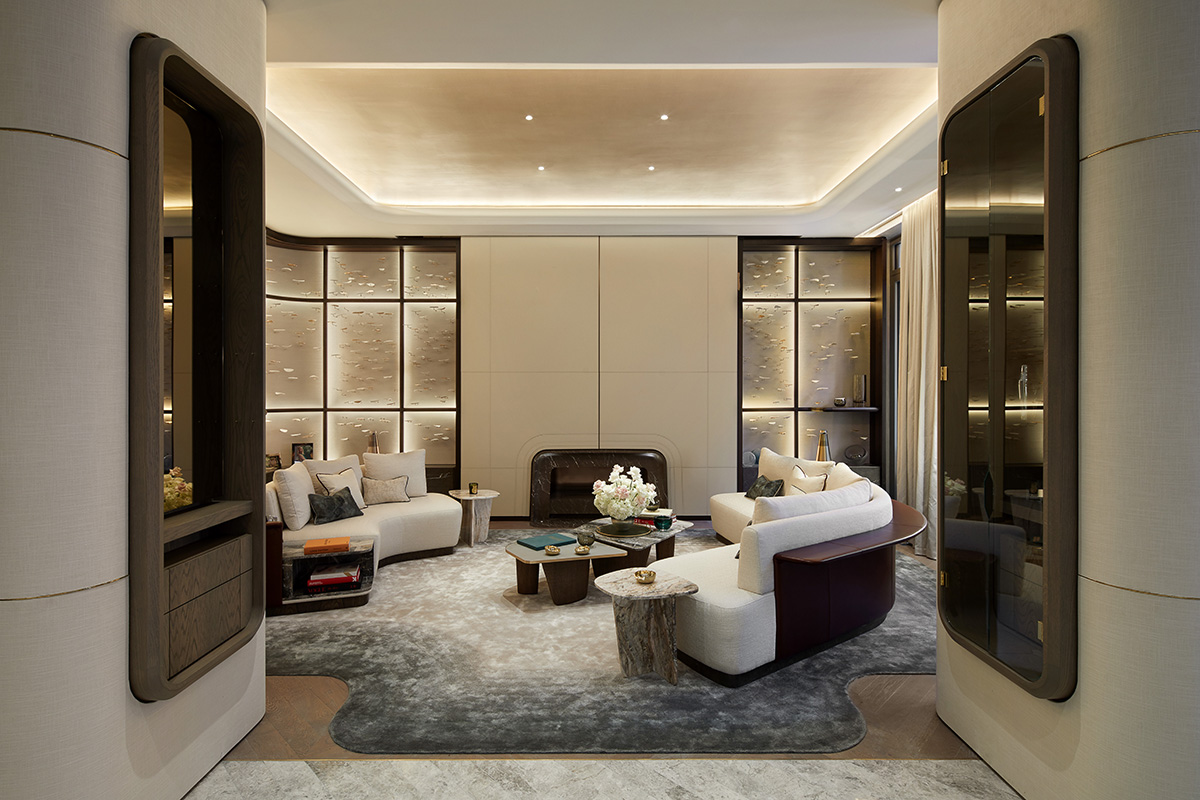
Maureen Bryan & Don McCollin in their studio. Photograph by Maryam Eisler
43 years ago, Don McCollin and Maureen Bryan met and formed a bond which would later result them to become an iconic duo in experimental design of furniture and objects. LUX’s Chief Contributing Editor, Maryam Eisler, speaks to the pair about the philosophy behind their works.
Maryam Eisler: How did you two meet and start working together?
Don McCollin: We met at Middlesex Poly college, 43 years ago in 1979. We didn’t know each other at first and then after we left in 1982, we kept in contact. We started by printing T-shirts and doing little projects like that. The first thing was a collection of Caribbean flags on t-shirts at the Notting Hill Carnival. We also printed textiles together. Eventually, we made a clock, which ended up being John Lewis’ best-selling clock! The idea was to make things. Make and sell. It’s also always been about materials. Our first commission was to do all the furniture for the restaurant at the Geffrye museum (now, the Museum of Home) in the East End.
Follow LUX on Instagram: luxthemagazine
Maryam Eisler: If you had to boil down the ethos of your business today to one or two words, how would you best describe it?
Maureen Bryan: One or two words is going to be difficult. In a few words, both of us want to make pieces that cause a reaction in the viewer, a sort of pleasure zone. We want to move people and make them go ‘ah’. It doesn’t have to be intellectual, but it has to be from the heart. It is also about keeping the artistic integrity in what we make. We still want to put that individuality into each and every design. The pressure is on us to increase production but we’ve stuck to our guns in not wanting it to run out of control.

The Aurora Folding Screen in shades of blue with a brass frame. Limited Edition of 8
Don McCollin: Yes, I always give the analogy that if I couldn’t do this, I would have loved to be a musician because music has that kind of power, to move people. I try to do what I do and have that exact reaction in people. There is always the idea of every single piece being slightly different even if the intention is not there. It’s about those accidental moments.

Photograph by Maryam Eisler
Maryam Eisler: Tell us about the importance of light and translucence in your work.
Maureen Bryan: My very first inspiration was a dream of a glass with ice cubes in it, and the light play. We initially made several key pieces using old lenses, old pieces of glass. We looked at the transparency of say Murano glass where you get that special depth of colour. We like playing with the depth of colour because it allows you to see more in a piece. We also started experimenting with domes on top of mirrors and realised that you get layers of reflection as well as layers of refracted light.
Read more: Alain Ducasse & Dom Pérignon’s Ephemeral Dining Experience
Don McCollin: It’s not always about what is there in front of you; it also has to do with your depth of concentration at the time of observation. Depending on where you concentrate when you look at a piece, that will then inform the perceived reflection.

Photograph by Maryam Eisler
Maryam Eisler: Do you ever consider your work in a more philosophical, poetic manner: thinking about multiple realities, imagination versus reality, the conscious versus the sub-conscious, shadow and light?
Maureen Bryan: I think we do subliminally, without necessarily articulating it. Perhaps we should try to articulate our philosophies more, but we’ve worked together for so long that we instinctively know what we’re individually talking and thinking about. In design, It’s not just how something looks on the surface; there’s always a multitude of layers and depth.

The Cendrillon table, clear resin with a gilded pattern. Limited Edition of 20.
Maryam Eisler: I see beauty in your work. Is that a taboo word or are you okay with the concept of beauty?
Don McCollin: I am. I very much like to produce things that people end up liking, objects that have a certain romantic beauty about them. And, I’m highly unapologetic about it all. There might be some link to my textile background. I trained initially in textiles, in brightly coloured beautiful things. And I allowed beauty to just be there. So it’s not necessarily a bad word.
Maureen Bryan: Beauty is a funny word to use because it is so avoided by society. I think we have avoided articulating it too much because we feel it may in fact over-intellectualise a concept. You don’t want to have to explain it necessarily.

Photograph by Maryam Eisler
Maryam Eisler: What other characteristics do you take into consideration when designing?
Don McCollin: Another dimension which we sometimes incorporate into our designs is humour. When we first started making the beans, I always used to put a penny in there because I thought: if they’re not going to be of any worth, at least they will always be worth a penny!

Photograph by Maryam Eisler

Photograph by Maryam Eisler
Maryam Eisler: In terms of the production techniques which you use, it’s not just about the physical hand at play, you also have technology and robotics which together with the human hand create these unique pieces. Can you tell us more about that?
Maureen Bryan: Yes, we have a robot! It was born out of the problem of polishing for 8 hours a day. We soon realised that people were in fact at risk of getting repetitive strain injuries, so we thought about how we could best to alleviate that. Hence the use of the robot. The machine we use was made in Germany and we had it commissioned especially for us. We are not using machinery to create, but rather to lighten the load and purely save people’s bodies.

Photograph by Maryam Eisler
Maryam Eisler: It’s so refreshing to see that you still start a piece by hand, in quite an old school kind of way, that you first draw it and turn the drawing into a hand-made maquette, contrary to many other designers who solely use computer programs to materialise their design vision.
Maureen Bryan: That’s always how we start because we can relate to it better. It’s also a handy way of sending it onto the manufacturer. We don’t think through the computer but rather by holding a pencil in hand.
Read more: Pioneering Artist Michael Craig Martin on Colour & Style
Maryam Eisler: How important is the space in which you work?
Don McCollin: We get a lot of inspiration just by being in the workshop and playing with things and little ideas.
Maureen Bryan: In a world where there is a lot of ugliness, we have a strong ethos in the workplace, a sanctuary where people are kind to each other. We have a really nice team and we make our work environment as pleasant as possible with a good, positive vibe. I would like to think that this is a place where we can escape from [the world]. It helps your head a lot actually, and the team does make it work. I also think this is the best team we’ve ever had. They’ve all been with us for years.

Photograph by Maryam Eisler
Maryam Eisler: Why do you think British designers do better outside the UK than they do within the country?
Maureen Bryan: I really don’t know what the explanation to that is. Maybe people are not so educated in design here in the UK. You see people here are very keen to build an architectural statement but then they furnish it in a bog-standard kind of way. I think it’s education, but also wealth in the UK is associated with tradition. Our biggest market is actually America!
Maryam Eisler: What is your dream for the future ?
Maureen Bryan: What we both want to do is to have more space to create more pieces and to have more time to design in a more hands on kind of way, with less time spent on management.
Find out more: mccollinbryan.com

















Recent Comments